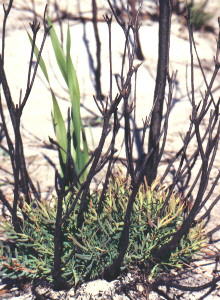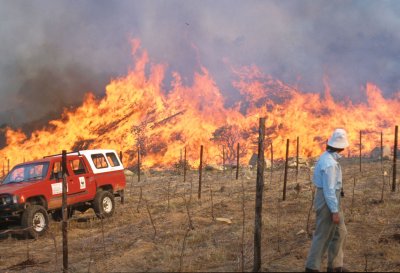
Home
Mission
Overview of Project
Project Staff
Sponsors
Achievements
Checking, Illustrations
Upcoming Activities
Id and Species Lists
Protea Information
Protea Gallery
Growing Proteas
Interim Dist. Maps
Publications
Afrikaanse Inligting
![]()
Surviving Fires
| Fire is one of the most characteristic features of both the Cape Floral Kingdom and the African savannas and grasslands and most proteas are adapted to survive fires in one of four ways: |  |
Storage of seeds in fire-safe environments by serotiny (eg. Common Sugarbush - Protea repens) and myrmecochory (eg. The Pincushion - Leucospermum cordifolium).In Africa, these fire survival strategies are largely confined to the Cape Floral Kingdom where many species have no other fire survival mechanism. Plants may take from 3 to 15 years to flower for the first time. Therefore, these species are susceptible to fires which occur at intervals shorter than those needed to produce seeds. In contrast to the previous strategy, adult plants may also survive fires by:
- Growing in a fire-safe environment (escape strategy), such as in rocky crags (eg. Protea rupicola), by creeping along the ground where fires are cooler (eg. Protea scabriuscula), or by creeping underground like ferns (eg. Protea acaulos). Protection in these environments is relative, and fierce fires might well kill these plants.
- Producing a thick bark which protects buds in the stem (stem resprouting strategy; eg. Wagon Sugarbush - Protea nitida). Growth of these epicormic buds is stimulated when branch tips are killed by fire. However, fierce fires may kill epicormic buds beneath bark, and some species with very thick bark seem not to have epicormic buds and are easily killed by fire (eg. Silver Tree - Leucadendron argenteum).
- Hiding underground. These plants tend to have large boles or rootstocks, which are thick, underground stems (bole resprouting strategy; eg. King Sugarbush - Protea cynaroides). These contain many dormant buds which, after a fire has killed the above ground portions, are stimulated to produce more growth. Many of these species only flower for a few years following a fire and then become inconspicuous. This strategy can easily be recognized by its multiple-stemmed habit, with many erect stems arising at ground level.
Resprouting after a Fire

Common Sunshine Conebush - Leucadendron salignum
The Effect of Fires on Proteas

This is a colony of the Silver Sugarbush - Protea roupelliae and Common Sugarbush - Protea caffra in the Kromdraai Conservancy.
Left Hand Side of Fence
The trees in the middle background on the left hand side of the fence are a
mixture of the Silver Sugarbush and the Common Sugarbush . This is private land
which is not under any form of conservation management.
Right Hand Side of Fence
On the right hand side of the fence is the Jack Scott private nature reserve
which is burned too frequently where no Silver Sugarbushes or Common Sugarbushes are to be
found. This is even though the habitat is identical to the left hand side of the
fence!
The survival of fynbos depends on fire at suitable intervals

Simonsberg Working for Water winter burn experiment - August 1999
Back Protea Ecology